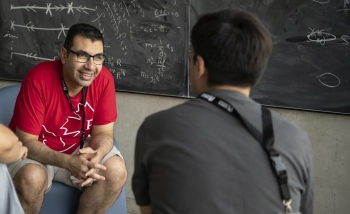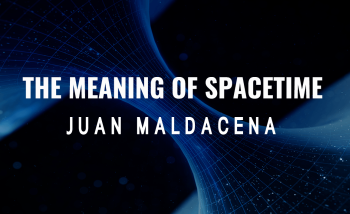It was late 2013, and Perimeter Institute quantum matter researcher Roger Melko had noticed something interesting about the quantum materials he was modelling.
Melko simulates “strongly correlated lattices,” exotic materials in which the tiny, quantum elements are linked together – or entangled[1] – in ways we are yet to fully understand.
Each lattice Melko simulated was vastly different, and yet the entanglement pattern at the corner regions of each system seemed to be producing eerily similar physics. Curious, he shared his calculations with condensed matter postdoc William Witczak-Krempa, who was taken with the data and started puzzling over it.
Two floors above them at Perimeter Institute, Pablo Bueno was a graduate student excited to be at PI and keen to work with another Perimeter faculty member, renowned string theorist Rob Myers. Myers agreed to take him on as a student; the problem was, he didn’t have anything specific for Bueno to work on.
Then, one day, Melko mentioned the strange similarities of corner entanglement to Myers. A light bulb went off. Myers had found the perfect project for his new student.
This is how the story begins, a collision of people and ideas that has proved to be more powerful than its parts, which is fitting, because that is exactly the lesson that Bueno, Myers, and Witczak-Krempa – brought together by a mix of curiosity, timing, and proximity – found in the data.
In four papers published over this spring and summer in Physical Review Letters, the Journal of High Energy Physics, and on arXiv.org, the trio detail a new angle for quantum physics.
They show that entanglement entropy[2] at corners produces exceptional physics that can act as a link between vastly different systems. And because the unusual physics of corners is universal, the relationship they uncovered may soon provide a tool to compare theories of vastly different types.
There is, it seems, magic in the meeting points.
*
In physics, corners are everywhere. From acute corners that look like a pin, to obtuse corners that are close to a straight line, to the pointy end of a 3D cube, corners have for years been the subject of much study and analysis.
But it’s hard to compare corners in different conformal field theories (CFTs)[3], and to understand what the corner region entanglement is telling us about a given CFT.
Scientists know that corners are interesting places. When a strongly correlated system reaches a phase transition, the quantum spin entanglement of particles at the corner regions extends and stretches far beyond the corner itself.
Thus, studying corner entanglement provides information about the long-distance structure of entanglement. This long-distance glimpse opens the door to scale-invariant physics.
But computing the entanglement entropy of corners is fiendishly difficult. Even when people have managed to define the contribution corners make to the entanglement of a CFT, it was unclear what those result were actually telling us.
Bueno, Myers, and Witczak-Krempa believe they’ve unravelled part of the puzzle.
They found that the energy density of a system correlates with the entanglement entropy of an almost-smooth corner (just shy of 180°) in that system.
More precisely, the team derived a relation between corner entanglement entropy and the “central charge,” which is a measure of the energy density of a system.
When you plot this relationship for different CFTs on a graph, each plotted line follows a similar curve before collapsing at the same “almost-smooth” point.
“The amazing thing is, everything’s on the same graph,” Myers says. “You’re including data from things that have infinite degrees of freedom, and things with one or two degrees of freedom. But everything fits.”
Even away from the “nearly-smooth” limit, the results for non-interacting particles, and for strongly interacting systems described by gravity in one higher dimension, are very close together.
“It’s puzzling,” says Witczak-Krempa, who recently took up a postdoctoral position with Subir Sachdev at Harvard and next year will be an assistant professor at Université de Montréal. “Why do they agree so well away from that limit as well? That’s a bit of an open question.”
*
The three researchers came to the problem from different angles: Witczak-Krempa works in field theories describing condensed matter systems; Bueno was finishing his thesis on black holes and supergravity under Tomás Ortín at Universidad Autónoma de Madrid; and Myers is a holography[4] specialist.
Witczak-Krempa was working alone, comparing the corner entanglement in different many-body quantum systems to look for a common thread.
Bueno, working with Myers, focused on holographic theories. “Our main results came at the very last stages of research, after quite slow progress for several months,” Bueno says.
Along the way, Bueno sought to make their work public, but Myers rebuffed suggestions that they publish. Describing himself as “an old guy who’s got a lot of papers,” Myers wanted to wait until they had a strong story to tell. “I just didn’t see it,” he says.
And he suspected there might be more to discover. He put the challenge to Bueno: Why not compare their holographic work to some non-holographic theories?
He pointed Bueno towards the work of Argentinian researchers Horacio Casini and Marina Huerta, who study free field theories, in which the particles of the system do not interact with each other. (The particles can, however, remain in an entangled state.)
In 2006, Casini and Huerta had performed a series of extremely complex computations to analyze the entanglement entropy of free-field angles, from almost-smooth to needle-sharp.
Bueno, by then back in Madrid, tried the holographic ratio on Casini and Huerta’s free field calculations. This was to be the finishing touch before he and Myers published a paper on the topic. He plotted the results on a graph, and the lines were “all over the place.”
Still, Bueno wrote a draft paper. Myers sent it to some colleagues for feedback. Casini, in Argentina, wrote back to point out that Bueno had left out a coefficient in the calculations for scalar fields[5].
When Bueno introduced the modification in the plots, the curve for the scalar field dropped down the graph to exactly touch the holographic result in the almost-smooth limit.
He then factored the missing coefficient into the fermionic field[6] calculations. The fermionic curve moved up the graph, and met the holographic and scalar curves at the almost-smooth limit.
“I started to run, telling everyone in my office that we had discovered something cool,” says Bueno, who will soon take up a postdoctoral position at the University of Leuven.
“The calculations for the holographic theories and free fields were so extremely different that it felt like something magic was going on. Of course, in the end, it’s just physics. It works, you know.”
The graph that had previously looked like “a mess” now showed the same curve for all different kinds of fields. Finally, Myers was convinced that they were truly onto something. “It’s only after the graph was fixed that I became a believer,” Myers says.
Myers then received an unexpected email. Witczak-Krempa had reached out to ask about an aspect of corner entanglement.
Working on his own, Witczak-Krempa had come to the same conclusion as Myers and Bueno: the entanglement of an almost-smooth corner is proportional to the energy density of a system.
“I was a little surprised anyone was thinking about it, let alone coming up with the same answer,” Myers says. “It made the story all the more compelling.”
They decided to combine their results and write a paper together.
*
In a significant move for theoretical physicists who probe entangled systems, the contribution of corner entanglement entropy to the entropy of the region under study might be measurable because it correlates to energy density.
“Not much is understood about corner entanglement, so if you can relate entanglement to better understood quantities, with things you can even measure, it’s very good,” Witczak-Krempa says.
“Some of the statements we haven’t proved, because we don’t have the skills yet, but we’re pretty excited about this advance. It gives you a stepping stone to understanding complex data. By relating entanglement to local quantities at certain limits, you have a handle – at least in certain limits – on the whole system.”
The possibility of having a bridge to compare different CFTs is one thing. Having proof of it is another. Myers is optimistic they’ll have that proof soon.
“I think we have all the right ideas; it’s just that they’re not quite fitting together,” Myers says. “I thought it would be easy, but it’s still a challenge. It seems very compelling, but being able to show people there is a general proof is still an open project.”
What will this lead to? It’s too early to tell. This new tool could lead to new insights for quantum field theory; it could provide a new perspective on entanglement entropy; it might even have implications for quantum gravity.
For Myers, though, the wait to publish was worth it. “It’s a long road, and you take a lot of small steps,” Myers says. “We could have put a paper out a year ago, and it would have been lost. By putting all the pieces together, we found something.”
[1] Entanglement is one of the key things that distinguishes the quantum realm from the macroscopic scale. Described by Einstein as “spooky action at a distance,” entangled particles become synchronized – or correlated – and stay that way, even after they are separated spatially. (Read Symmetry magazine's 60-second explainer.)
[2] Entanglement entropy is associated with the information you lose when you isolate a region to study its properties. By “cutting out” part of the system to study, you inevitably leave some entangled partners out of the equation. This corresponds to missing information, which corresponds to entropy.
[3] A conformal field theory is a quantum field theory in which the physics of the system doesn’t change (i.e. remains invariant) when length scales change. In essence, CFTs look the same up close or far away, no matter how much you zoom in. They care about angles, but not distances.
[4] Holography is the observation that certain two-dimensional theories can be described by a completely different-looking theory in three dimensions. Like a hologram, all the information you need to build a 3D “picture” of a theory is captured on the two-dimensional surface of its holographic dual theory.
[5] A scalar field is one in which every position in the space has only one number. It’s like temperature: at any point in space, you can identify a single number that describes it.
[6] A fermionic field describes the behaviours of fermionic particles, like protons and electrons. Such fields associate more than one number to a given point in space, making them more complicated than scalar fields.
Further exploration
About PI
Perimeter Institute is the world’s largest research hub devoted to theoretical physics. The independent Institute was founded in 1999 to foster breakthroughs in the fundamental understanding of our universe, from the smallest particles to the entire cosmos. Research at Perimeter is motivated by the understanding that fundamental science advances human knowledge and catalyzes innovation, and that today’s theoretical physics is tomorrow’s technology. Located in the Region of Waterloo, the not-for-profit Institute is a unique public-private endeavour, including the Governments of Ontario and Canada, that enables cutting-edge research, trains the next generation of scientific pioneers, and shares the power of physics through award-winning educational outreach and public engagement.
You might be interested in

Perimeter Hosts Strings 2023: Spotlighting new directions and uniting a community
September 22, 2023


